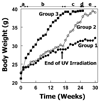Rapid body weight gain increases the risk of UV radiation-induced skin carcinogenesis in SKH-1 hairless mice
- PMID: 19083457
- PMCID: PMC2680186
- DOI: 10.1016/j.nutres.2008.05.009
Rapid body weight gain increases the risk of UV radiation-induced skin carcinogenesis in SKH-1 hairless mice
Abstract
Although it is well known that caloric restriction reduces the risk of chronic diseases including cancer, the role of weight gain in the development of UV light-induced tumors has not, to our knowledge, been investigated. In view of the increase in obesity worldwide, we asked the question whether there is any relationship between body weight gain and skin tumor development. We subjected 3 groups, each composed of 30 SKH-1 hairless female mice, to UV radiation (30 mJ/cm(2), twice weekly for 17 weeks) and observed tumor formation over the ensuing 8 to 13 weeks: group 1 received pelleted diet; group 2 received pellets during the irradiation period and was then switched to powder; and group 3 received powder exclusively. At the end of the experiment, the mean body weight of group 1 was 32.1 +/- 0.5 g, whereas that of groups 2 and 3 was 39.0 +/- 1.5 and 39.5 +/- 1.4 g, respectively. Tumor incidence reached 90% at 8 weeks after completion of irradiation for the animals in group 3 and at 13 weeks for the animals in group 2. Similarly, at 8 weeks after irradiation when all animals of group 3 were euthanized, tumor multiplicity was 0.8, 1.2, and 3.2 for groups 1, 2, and 3, respectively. Thus, in comparison with the mice consuming pellets, the powder-fed mice gained weight more rapidly and developed tumors much faster. Considering the escalating numbers of individuals worldwide who are overweight or obese, our findings provide further impetus for advocating healthier diets and maintenance of constant body weight in adults.
Figures


References
-
- Lane MA, Black A, Handy A, Tilmont EM, Ingram DK, Roth GS. Caloric restriction in primates. Ann NY Acad Sci. 2001;928:287–295. - PubMed
-
- Bordone L, Guarente L. Calorie restriction, SIRT1 and metabolism: understanding longevity. Nat Rev Mol Cell Biol. 2005;6:298–305. - PubMed
-
- Tannenbaum A. Effects of varying caloric intake upon tumor incidence and tumor growth. New York Acad Sci. 1947;49:5–18.
-
- Tannenbaum A, Silverstone H. The influence of the degree of caloric restriction on the formation of skin tumors and hepatomas in mice. Cancer Res. 1949;9:724–727. - PubMed
-
- Tannenbaum A, Silverstone H. Nutrition in relation to cancer. Adv Cancer Res. 1953;1:451–501. - PubMed
Publication types
MeSH terms
Grants and funding
LinkOut - more resources
Full Text Sources
Medical

